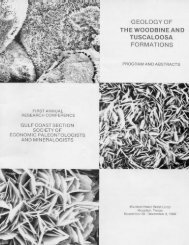Petroleum Systems of Deep-Water Basins - Gulf Coast Section SEPM
Petroleum Systems of Deep-Water Basins - Gulf Coast Section SEPM
Petroleum Systems of Deep-Water Basins - Gulf Coast Section SEPM
Create successful ePaper yourself
Turn your PDF publications into a flip-book with our unique Google optimized e-Paper software.
The <strong>Deep</strong> <strong>Water</strong> <strong>Gulf</strong> <strong>of</strong> Mexico <strong>Petroleum</strong> System:<br />
Insights from Piston Coring, Defining Seepage,<br />
Anomalies, and Background*<br />
G. A. Cole<br />
A. Yu<br />
F. Peel<br />
C.H. Taylor<br />
BHP <strong>Petroleum</strong><br />
1360 Post Oak Blvd., Suite 500<br />
Houston, Texas 77056<br />
R. Requejo<br />
Geochemical Solutions International, Inc.<br />
2203 Timberloch Place Suite 235<br />
The Woodlands, Texas 77380<br />
J. DeVay<br />
Phillips <strong>Petroleum</strong> Company<br />
6330 West Loop South<br />
Houston, Texas 77401<br />
J. Brooks<br />
B. Bernard<br />
TDI-Brooks International Inc.<br />
1902 Pinon Dr.<br />
College Station, Texas 77845<br />
J. Zumberge<br />
S. Brown<br />
GeoMark Research Inc.<br />
9748 Whithorn Dr.<br />
Houston, Texas 77095<br />
*Published in this volume with permission<br />
Abstract<br />
In the early days <strong>of</strong> <strong>Gulf</strong> <strong>of</strong> Mexico piston coring, locations were chosen on a grid basis or selected from loose 2D<br />
seismic surveys. Such locations resulted in some seepage “hits,” but the majority had either a background signature or<br />
an “anomalous” value that was between a true visible seep and background (using fluorescence intensity and unresolved<br />
complex mixture content). A scale based on these early data identified anything 10,000 were classified as anomalies to seepage depending on individual company<br />
interpretations.<br />
With the advent <strong>of</strong> 3D surveys, it is easier to locate seepage-related seabed features using seafloor amplitude<br />
extractions related to migration conduits, such as faults associated with shallow salt features or deep-seated faults. As<br />
seepage sites are now better defined and as we have an extensive geochemical database, the old scale for background<br />
versus anomaly versus seepage has changed. By correlating true seepage to reservoired oil, most “anomalies” are not<br />
related to seepage or to the reservoired oils, and therefore, are not related to the subsurface petroleum system. The<br />
biomarker signatures can be used to define source origins, and when merged with regional understanding <strong>of</strong> source<br />
rocks in the greater <strong>Gulf</strong> <strong>of</strong> Mexico basin, a deep water source model can be derived. A 2D TemisPack model confirms<br />
the seepage results based on a deep water source rock model placing the primary source centered on the<br />
Tithonian and possible secondary source rocks at the Mid-Cretaceous Unconformity (MCU) and Oxfordian levels.<br />
18

















